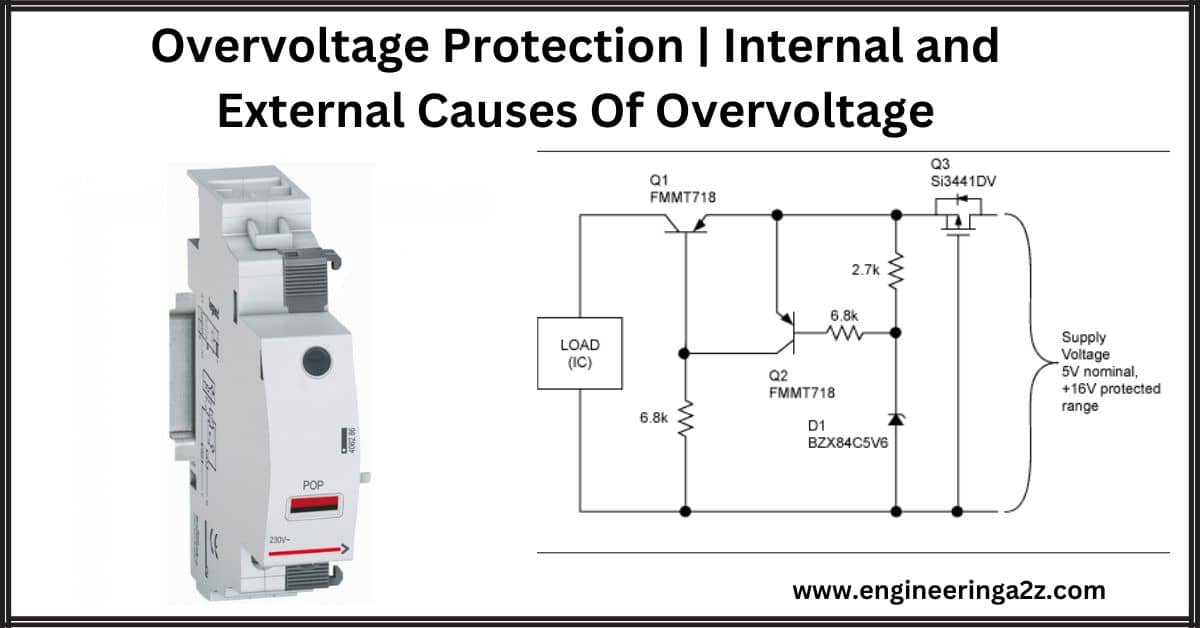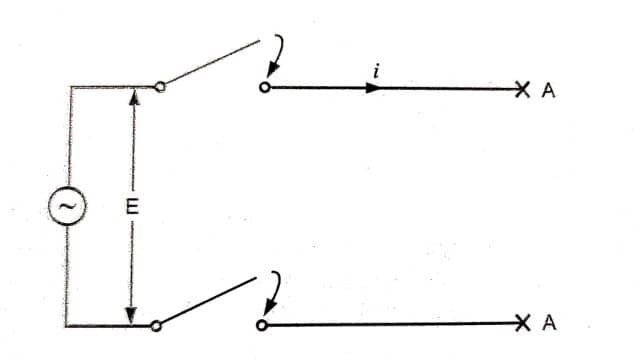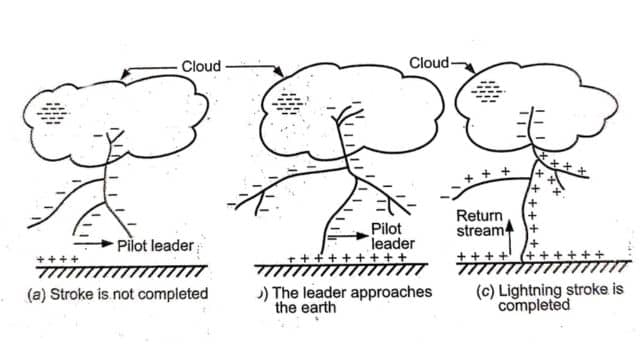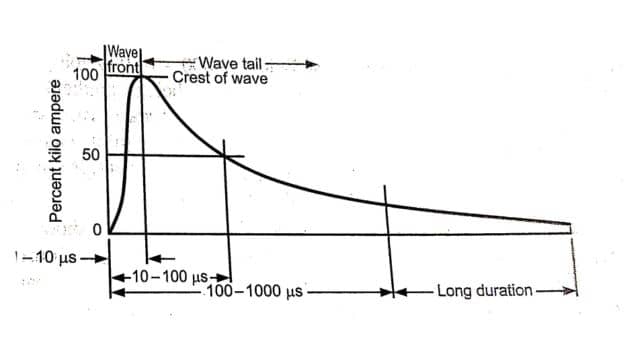
Table of Contents
Introduction
Voltages more significant than typical voltages are called overvoltages. These may affect the power system elements directly or indirectly. There are several reasons for such voltages such as lightning, the opening of a circuit breaker, the grounding of a conductor, etc. Most of the voltages are not of large amplitude but may affect the performance of a circuit interrupting equipment and protective devices. Some of such overvoltages may also cause insulation breakdown of specific equipment.
Voltage Surge
Switching high-voltage transmission lines is necessary for a power system to work. However, when we switch off an unloaded line, open or close switches, or interrupt currents in reactors and capacitor banks, it creates sudden voltage increases called surges or transients. These surges can damage equipment and make the system less reliable. Lightning strikes, although rare, are a significant cause of overvoltage and can lead to insulation failure. Transients and surges also depend on faults, system changes, and configuration alterations.
Causes Of Overvoltages
Overvoltages may occur in the power system due to
(i) Switching surges
(ii) Insulation failure
(iii) Arcing ground
(iv) Resonance.
1. Internal Causes Of Overvoltage
Internal causes of overvoltages in a power system occur when there are sudden changes in circuit conditions. These changes can be a result of normal switching operations, like opening a circuit breaker, or due to fault conditions such as a line conductor grounding. The prominent internal causes of overvoltage have been discussed below:
1. Switching Surges: The overvoltages produced on the power system due to switching operations are called switching surges. These may be as follows:
(a) Case of open line: During switching operations of an unloaded line, traveling waves are set up that produce overvoltages on the line. Consider an unloaded line connected to a voltage source as shown in Fig.

When the unloaded line is connected to a voltage source, a voltage wave is set up which travels along the line. On reaching the terminal point A, it is reflected back to the supply end without any change of sign. This causes voltage doubling i.e. voltage on line becomes twice the normal value. If Ems is the supply voltage, then the instantaneous voltage which the line will have to withstand will be 2√2 E. This overvoltage is of temporary nature. It is because the line losses attenuate the wave and in a very short time the line settles down to its normal supply voltage E. Similarly, if an unloaded line is switched off, the line will attain a voltage of 2√2 E for a moment before settling down to the normal value.
(b) Case of a loaded line: Overvoltage will be produced during the switching operations of a loaded line. Suppose a loaded line is suddenly interrupted. This will set up a voltage of 22 in line and Z, is the natural impedance of the line. For example, suppose the line having Z= 1000 2 carries a current of 100 A (r.m.s.) and the break occurs at a moment when the current is maximum. The voltage across the breaker (.e. switch)= 2√2 x 100 x 1000/1000 282-8 kV. If V is the peak value of voltage in kV, then the maximum voltage to which the line may be subjected is (V+282-8) kV.
(c) Current chopping: When using an air blast circuit breaker, current chopping can occur, leading to the production of high voltage transients across the breaker’s contacts. This abrupt current interruption is known as current chopping and can be mitigated by resistance-switching techniques.
2. Insulation failure: The most common cause of insulation failure in a power system is the grounding of a conductor (i.e. insulation failure between line and earth) that causes overvoltages in the system.
3. Arcing ground: In the past, the neutral of a three-phase power line was sometimes left ungrounded. This meant that in the event of a line-to-ground fault, the line would not be shut down or the interference with communication lines would be reduced. However, for long lines and high voltages, a serious problem called arcing ground would occur. This leads to severe voltage oscillations and transients that can damage equipment by causing insulation breakdown. To prevent arcing ground, the neutral is now grounded.
4. Resonance: This situation happens in a power system when the inductive reactance is equal to the capacitive reactance, causing the circuit impedance to match the resistance and the power factor to become unity. This can lead to high voltages in the power system. Resonance, where the impedance matches the frequency of the power supply, typically doesn’t occur in normal transmission lines because their capacitance is too small. However, if the waveform from a generator is distorted or when dealing with underground cables, resonance issues can arise due to higher harmonics (like the 5th harmonic).
2. External Causes Of Overvoltage
Internal causes do not produce surges of large magnitude. Surges due to internal causes hardly increase the system voltage to twice the normal value. Generally, surges due to internal causes are taken care of by providing proper insulation to the equipment in the power system. Surges due to lightning are very severe and may increase system voltage to several times the normal value. If equipment in the power system is not protected against lightning surges, these surges may cause considerable damage. The protective devices provided against overvoltages mainly take care of lightning surges.
Lightning phenomenon: An electrical discharge in the air between clouds, between the separate charge center in the same cloud, or between cloud and earth is called lightning. Cloud containing ice particles and dust acquire electric charge due to the friction with air.
When the charge acquired by the cloud increases, it results in an increased potential between the earth and the cloud (lightning occurs at a potential of about 5-20 million volts) or in other words potential gradient increases, when the gradient is sufficient (5,000-10,000 volt per cm) to break down the surrounding air, a flash occurs from cloud to earth. Further, as the gradient is not uniformly distributed, it is more at the center of the cloud. The initial Nash starts from the cloud and carries accumulated charge along with it as illustrated in Fig.

The pilot leader continues downward descent until its tip maintains proper breakdown potential gradient, if it is not maintained the complete stroke is not formed or it does not reach the earth. When the pilot reaches the earth, an electrostatic field is increased and a flash shoots up from the earth resulting in a sudden spark and contact with the center of the cloud and earth.
The rise of current is quicker than decaying it reaches its peak value and then decays down. This current from the earth terminal is similar to that of a current from a charged condenser. A lightning stroke is made up of a number of separate strokes. The time interval between them is 0-005 s to 0-5 s. Each separate stroke starts as the downward leader from the cloud.
The wave shape of lightning stroke: As said earlier lightning stroke current rises to crest value quickly and then starts decaying at a low rate as shown in Fig.

The generalized wave shape can be characterized as:
(i) Crest or peak value and is observed that the maximum value of current is 400 KA.
(ii) The wavefront line varies from 1 to 10 us.
(iii) The time at which stroke current reduces to 50%, then crest value has been estimated that time varies from 10-100 μs.
Frequently Asked Questions (FAQs)
What is overvoltage protection?
Overvoltage protection safeguards against excessive voltage levels to prevent damage to equipment and ensure the reliability of the power system.
What is a lightning phenomenon?
An electrical discharge in the air between clouds, between the separate charge center in the same cloud, or between cloud and earth is called lightning.
What is the earthing screen?
An earthing screen is a conductive layer or shield surrounding a power conductor to protect it from external electromagnetic interference and improve safety by providing a path for fault currents.
What are the causes of voltages?
There are two types of causes of overvoltages:
(i) Internal cause of overvoltage
(ii) External causes of overvoltage.What is multigap arrester?
A multigap arrester is a protective device with multiple spark gaps that provides effective overvoltage protection by diverting excess electrical energy to the ground.
Read Also:
- Power Factor Meter | Dynamometer Type
- Energy Management | Need and Environmental Aspects
- Supply : Law of Supply
- What is Thermocouple | Construction & Working Principle
- High Voltage Direct Current (HVDC) Transmission
- Solar Cookers | Working Principle, Construction, and Applications





Leave a Reply